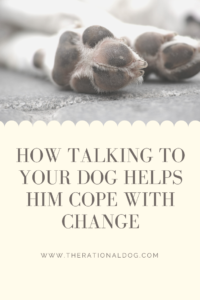Sometimes in life, things change. We can all attest to this. Whether you’re bringing home a new baby, moving to a new house, or anything else that’s a big change, nothing stays the same. One of the major concerns that I hear from folks in a state of transition regarding their dogs is this: “How can I help my dog cope with change?” We are often very worried that our dogs are very set in their ways, and won’t welcome the big changes that are about to hit their lives like a ton of bricks. However, with the exception of a few types of dogs that really do have trouble coping with change, the news is good!

Dogs, like children, are incredibly resilient creatures! You can see that simply by looking at how many rescued dogs there are out there, thriving in their second, third, or fourth homes with the right guidance. If dogs can overcome the neglect and abuse that so many of them are exposed to, adjusting to the changes your family may be going through is not outside of their coping abilities.
That being said, there is one tool that I’ve found incredibly helpful in assisting dogs in accepting change, and that is Cognitive Training. This post will help you understand what Cognitive Training is, and 4 ways that it can assist you in helping your dog cope with new things!
What is “Cognitive Training?”
I guess the first question on your mind has got to be this one. What is Cognitive Training? How is it different from how you normally train your dog, and why is this not a technique that you’ve heard of before? Well, here are some answers for you!
“Cognitive Training” is a type of training based on “Cognitive Learning Theory.” While most animal training is based in “Behavioral Learning Theory,” this type of training gets its roots from the idea that we (and dogs) can learn new things through observing, categorizing, and generalizing information. Behavioral Learning Theory tells us that we (and dogs) learn simply through the consequences of our behavior – behaviors that are rewarded are strengthened, and behaviors met with negative consequences are diminished.
“Cognitive Training” is a blend between the two learning theories. We use behavioral principles to teach new behaviors, and to correct unwanted behaviors, through rewards and punishments. However, while many training styles stop there and leave it at that, with Cognitive Training we use a lot more language to explain changes in the animal’s life and environment, show them how new things work through demonstration and teaching small steps toward success, and we help them generalize these new skills to different situations.
Now that you understand a bit about what makes Cognitive Training unique to other training styles, let’s talk about how you can use its benefits to support your dog through the huge life changes that a baby will bring to your home!
1. You Can Explain What Is Changing.
Isn’t this something that you wish you could do in all sorts of situations with your dog? “I wish I could just tell him what is happening,” is a thing I hear all the time from dog owners. The funny thing is, you absolutely CAN tell him what is happening.

The secret is a technique called Name and Explain, which is a crucial piece of Synalia Training Systems. It’s what makes it a Cognitive technique, rather than simply another dog training style. You can learn more about SATS in general in this post, but for now let’s just focus on Name and Explain.
We all know that dogs understand so much more than a lot of people give them credit for. They learn the names of their toys, leashes, and daily activities through context, not by being taught with treats and rewards. You can do the same thing, teaching through context, simply by being purposeful and pointed in naming and explaining things in your dog’s environment. For example, when someone knocks on your door, you can tell your dog, “That’s the door. Someone is knocking.” Giving things a name takes confusion away and allows your dog to think about what’s going on.
So how does this apply to big changes in your dog’s life? Be purposeful in naming the new things that are coming into your dog’s home and life. “This is a stroller. This is the crib. That is the baby crying.” “This is our house. You hear the garage door. Those are the neighbor’s talking.” Pointing out the changes to your dog in a calm, knowledgeable way helps to take the confusion out of things. Even if everything is new to him, at least YOU seem to know what’s going on!
2. You Can Direct Your Dog How to Cope with Change.
So you are able to tell your dog what is new and different. That’s great. But it doesn’t seem to be helping a whole lot on its own. That’s where this second part comes in. When you tell your dog what is new in his environment, you’re doing the “Name” part of Name and Explain. Next, it’s time to do the “Explain” part.
When I tell people how to use this technique, here is how I describe it: You “Name” for your dog what is happening, or what is changing in the environment, and then you “Explain” to your dog what to do about it. Naming is a nice thing for your dog, but it’s not terribly effective until you take the time to Explain what they need to do to be successful in the face of all of this change.
It’s your job to remember to tell your pup what he should do to be correct. For example, “This is a stroller, you stay Off.” “The baby is crying, you go to your bed.” “The neighbor’s are talking, you stay quiet and easy.” And so on. Acknowledge that there’s a big change happening to help your dog realize that it’s no big deal, but then give them something to do with that information!
3. You Can Easily Tell Your Dog How He’s Doing.
As we bring more language into your dog’s training and his life in general, we add a way to explain how he’s doing at coping with big changes. When you train using cognitive techniques, one thing that helps incredibly is explaining things in opposing concepts. For example, on versus off, in versus out, bark versus quiet, and so on.
So, when your dog is figuring out how to respond to big changes in the house, it’s so helpful to be able to let your dog know WHAT they’re doing, and how you like it. Telling your dog, “Yes, good quiet and easy,” lets him know that those two particular behaviors are the ones you are looking for. Likewise, if your dog isn’t behaving appropriately, you can say, “You’re barking. You need to be quiet and easy.” That provides context to your dog about what needs to change, and gives them an idea of what to do to be right.
Whether your dog is doing as he should, or he needs to change his behavior a little bit, having the words and vocabulary on hand to encourage or to correct can give your dog the information he needs to keep on doing great things!
4. You Can Explain Shifting Expectations.
I think that this is the thing when something big in your dog’s life changes: Your dog has been living his best doggy life since he’s been with you. He knows his place, he knows his job, and he knows how to make you happy! Now, though, you’re bringing home a baby, you’re moving in with your parents, you’ve adopted your teenage stepchildren, so on, and your expectations for him are about to change (fairly drastically, in some cases).
Where your dog was once welcomed to leap from 8 feet away and land smack on your chest on the couch, that can’t be allowed now. The stealing of socks, towels, and other small stuffy things isn’t so cute when it causes a major meltdown because your little one’s favorite snuggle toy was destroyed. Barging through doors, or pulling ahead on walks are just plain dangerous now that you live on a busy boulevard in Downtown Dallas.
These changes in expectation can be very confusing for a dog, particularly if they’ve been living comfortably for a long time. But this is where the use of language can help your dog so very much. Rather than being surprised by a drastic change in your expectations, you can explain to your dog that things are changing (and of course reward your dog when they comply with the new rules!).
“The baby’s on the couch, you stay off,” is a good way to explain what’s different with furniture rules. “I’m opening the door, you wait,” lets your dog know that pulling isn’t an option…you’ve got other things to worry about. Being able to succinctly let your dog know what’s changed, and how to respond to it, greatly improves your relationship, reduces confusion, and keeps you both on the same page!
Where can You Get Started with Cognitive Training?
The next question, of course, is this one. Where can we get started with Cognitive Training? It’s not a type of animal training that is widely taught, particularly in the dog training world. Dog trainers tend to stick to behaviorally based training techniques.

There are a couple of us, though, who do use more language and cognitively based techniques in our training, with great success.
My course, Leading Your Dog, will get you started in building the right relationship with your dog so that doing this training is simple and easy.
You can also check out Kayce Cover, who developed Synalia Training Systems, and uses these techniques with many types of animals (not just dogs!) with incredible success. Have a look at her courses, and her YouTube channel, to get more info and insight!
Like and follow our Facebook page, and join our mailing list to learn more and stay up to date!
Of course, if you have questions or comments, drop a comment here and I’m so happy to answer them for you and get you started on the right path!